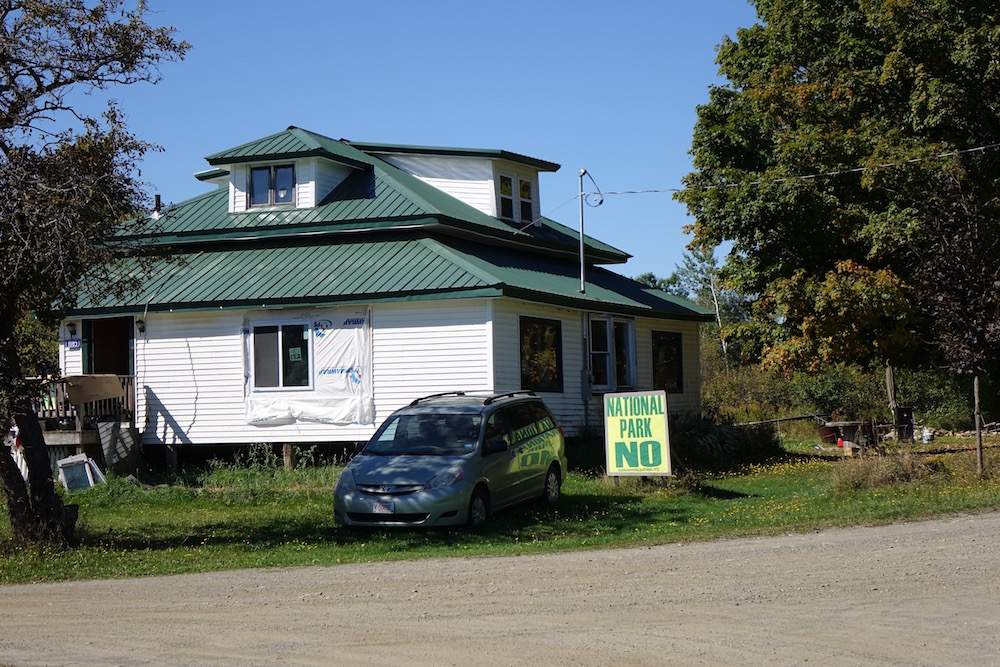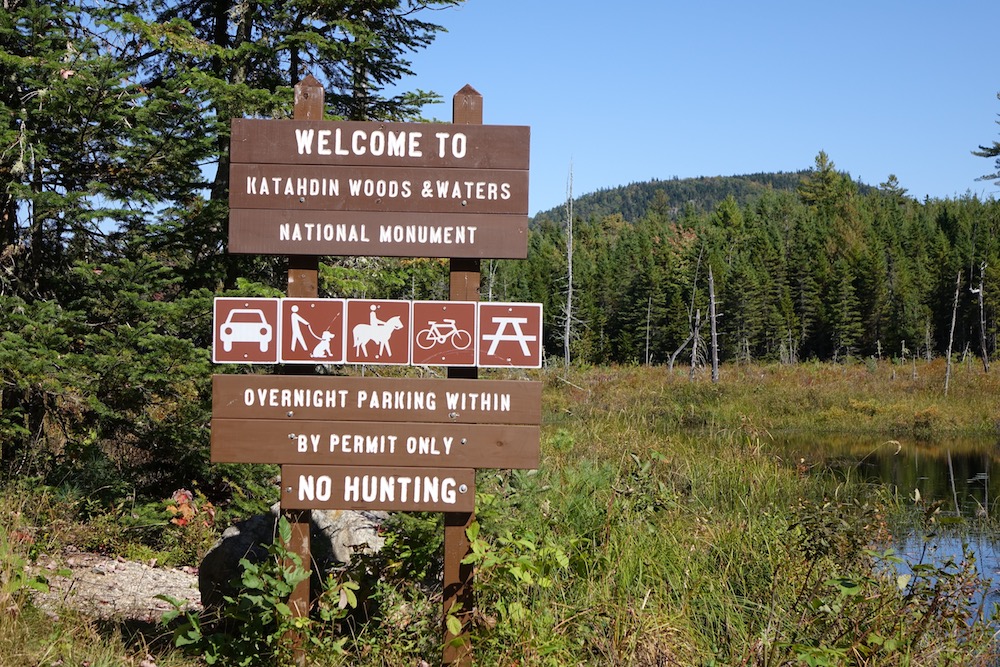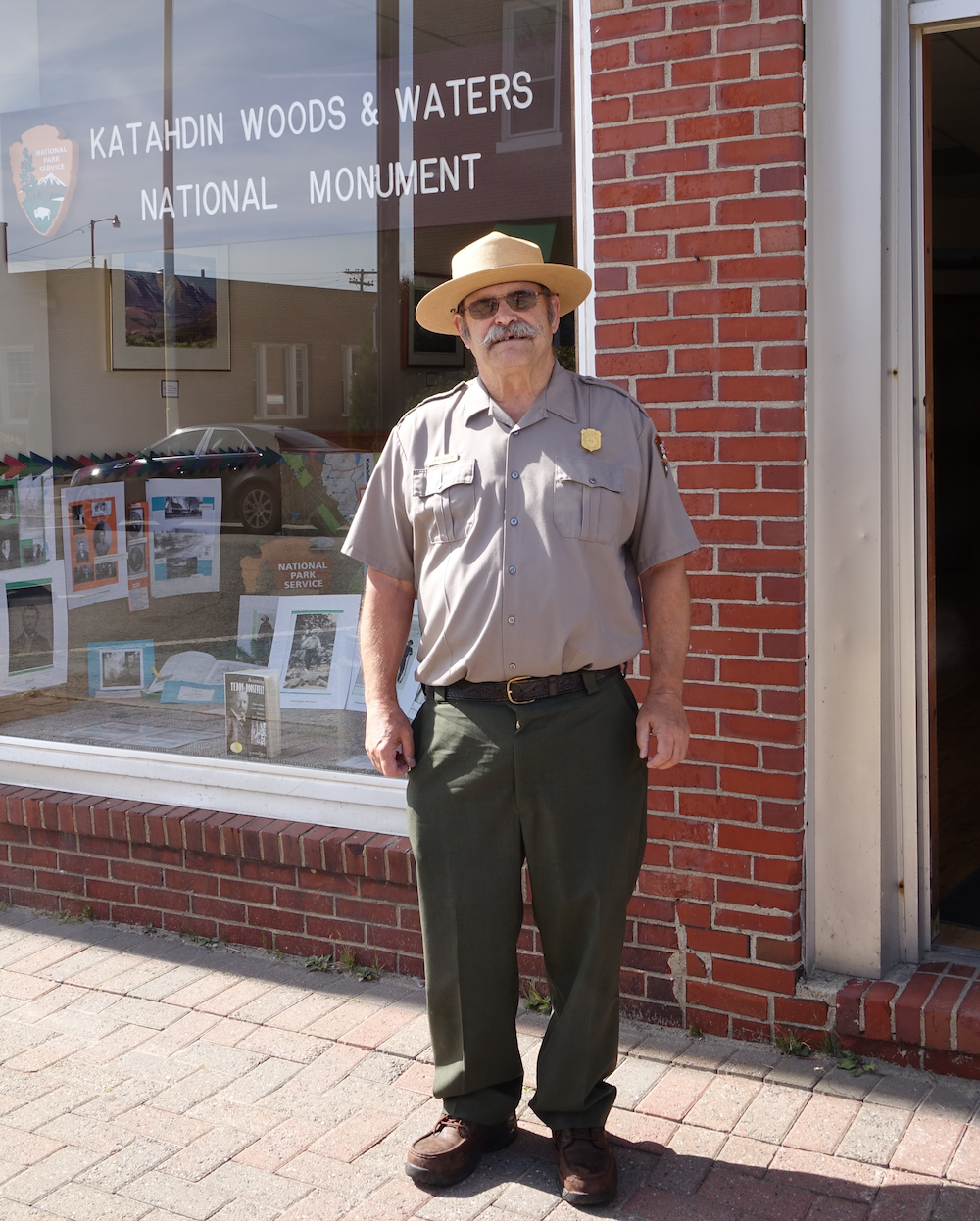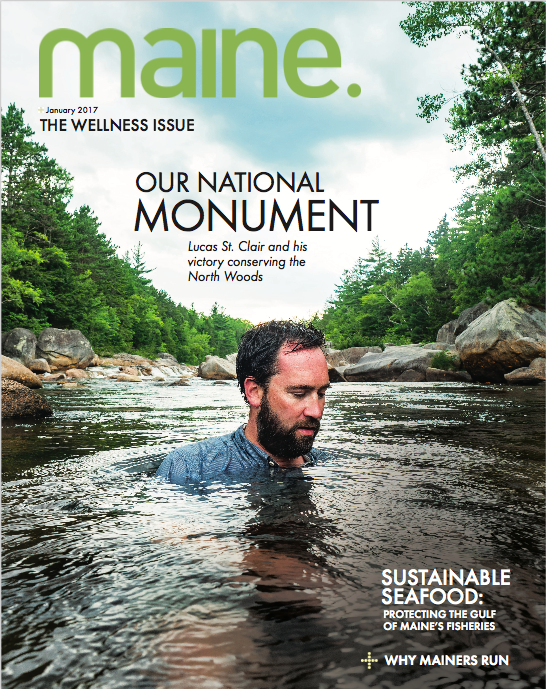Connecting state and local government leaders
But North Woods residents hope it will generate more activity in their fading economy.
MILLINOCKET, Maine — Tim Hudson’s well-marked and tidy office on the main street of this town, and his distinctive National Park Service uniform, convey a message about the federal government’s determination to exercise its powers over the new Katahdin Woods and Waters National Monument, a tract of 87,500 acres a few miles to the northwest.
Hudson’s is not an easy job. Scattered but vociferous protesting against the monument continues in areas surrounding it. Maine Gov. Paul LePage, who fought the federal designation, has not deigned to allow a single sign directing travelers its way. And the Trump administration apparently wants to change normal Park Service rules to allow logging within its boundaries. Superintendent Hudson, after 13 months on the job, is the only federal official assigned to Katahdin.
A visitor to the area in late September found local opposition that preceded then-President Barack Obama’s decision last year to create the monument softening. With little prospect that the prosperous timber industry of yesteryear will return, many local leaders are embracing tourism as an important answer to the region’s economic decline.
Hudson is at the center of the controversy. And his travails offer an East Coast example of what the West has long since learned: Marrying a Washington decree with local culture is a most difficult chore.
The controversy has attracted attention nationwide, earning coverage from the Associated Press, The New York Times, The Washington Post, and The Wall Street Journal among others. It was the subject of a detailed report by Route Fifty last year. And it will soon be brought to the screen in a documentary called “The Mountain and the Magic City” that’s under production by a team of award-winning filmmakers.
Visiting the Monument
For years, the Millinocket exit from Interstate 95, an hour north of Bangor, has been used by outdoorsmen and women aiming to climb Mount Katahdin, at 5,269 feet the highest peak in Maine. The mountain—and the northern terminus of the Appalachian Trail—are in Baxter State Park. Most of the new monument is directly adjacent to the state park.
It’s easy to find Baxter, but not so easy to find the Katahdin Woods and Waters National Monument. Ironically, the only road into the southern section of the monument is a turn off the “Katahdin Woods and Waters Scenic Byway,” an 89-mile stretch of Route 11 that gained the designation a few years back. One searches in vain for any description of the monument in the Byway brochure or on the Byway website.
At the turn onto Swift Brook Road, there’s no sign directing drivers into the monument but rather a huge “National Park No” sign on a householder’s lawn.

More such signs appear along Swift Brook Road. The road is rough, full of potholes and rocks. It takes half an hour to travel the eight miles into the beginning of the Katahdin Loop Road. There, finally, a large wooden sign proclaims: “Welcome to Katahdin Woods & Waters National Monument.”

Rick and Debbie LeVasseur, owners of the 5 Lakes Lodge near Millinocket, had warned that there wasn’t much to see along the way, and that proved to be the case. Burt’s Bees entrepreneur Roxanne Quimby, who assembled the land and gave it to the government, was able to buy it relatively inexpensively over the years from timbering companies because most of it had already been cut. Few big trees are visible from the road. The loop road is rough and pitted and enclosed almost entirely by the regenerating forest. A turnout offers a nice view of Katahdin, one of eight stops along the loop recommended by an interpretive map published by Friends of Katahdin Woods & Waters.
The monument also extends far north of the loop road, accessible to the adventurous who can drive the rough logging roads or travel by snowmobile in the winter. Hunting is allowed there, though not along the loop road.
The Monument and the Economy
Logging roads are what began to generate back-woods tourism here in the 1970s. Great Northern Paper Co. tracked visitors to its road system and counted as many as 165,000 in 1985.
There’s been scant increase in the number of climbers, hunters, fishing enthusiasts and other outdoorsmen visiting in recent years, guesses lifelong resident Dan Corcoran, owner of North Woods Real Estate in Millinocket.
But Corcoran believes the new monument is generating interest in the region. “It’s like a big spotlight was suddenly shined on this area, bringing it to the attention of people in this country and around the world,” he said in an interview.
He tells the story of a Florida man whose one-night stay in the lovely 5 Lakes Lodge extended to five weeks, and made him an investor in an island and other properties.
Corcoran says there’s a pickup of business in lakeside cabins and other residences, “but the biggest change is in commercial real estate.” That category was dead for years, but since the monument was announced, the phones have been ringing in his offices, he says. There’s a new Dollar Tree store in town, a new sporting goods store, a new restaurant, and a $5 million youth outdoor educational facility under construction.
There’s new commerce toward the northern end of the monument as well, in the town of Patten—a new barbecue shack and an expansion of the hardware store to include sales of sporting goods.
While the days of the big paper mills is over along the Penobscot River, Corcoran believes the timber-rich area may attract smaller forest products concerns to a 1,400-acre industrial park Millinocket has established. New technologies have made it possible to use wood to manufacture products like dish cloths, insulation boards and items usually made of plastic.
Corcoran has seen the uptick in his own business. In the past year, the number of realtors in his firm doubled from three to six, and he is in talks to expand by another two.
A Long Climb
If real estate prices are firming up, it’s after many years of decline. Rick LeVasseur tells about a house his son-in-law bought in 2005 for $62,000. He invested $18,000 in improvements. But now he wants to move on, and the house is on the market for $29,000.
That’s been the story of the region ever since the big paper mills began closing down. Millinocket’s population is only about half its peak of 7,700 in the 1970s. Once called the “Magic City” because it sprung out of the woods so quickly and became the wealthiest area of the state, the town has a downtrodden mien today.
With no obvious substitute for the paper and pulp industries, local leaders set their sights on tourism. Various partnerships sprang up to promote the area.
Tourism advocates took heart when Quimby and her son, Lucas St. Clair, began their serious push to create a national park. The land they had been assembling for close to 15 years was held in a private foundation created in 2002, Elliotsville Plantation Inc., and they wanted to give it to the government.
But they faced serious obstacles—opposition from the governor and skepticism among members of the state’s congressional delegation, who wrote, in a letter to Obama in 2015, that “Mainers have a long and proud history of private land ownership, independence, and local control, and do not take lightly any forced action by the federal government to increase its footprint in our state.”
A new national park requiring an act of Congress was not in the cards. But Obama had power under the 1906 Antiquities Act to designate a national monument, and he did so on Aug. 24, 2016, after accepting many of the conditions the Maine delegation wanted included in the proclamation.
After that, local opposition seemed to recede. Many anti-park bumper stickers and signs disappeared, said John Hafford, who runs a design and marketing firm, designlab, in the center of Millinocket.
But many still worried that the new national monument would encumber National Park Service funds needed for operations in the parks and to address a huge maintenance backlog.
And LePage has remained opposed—going so far as to label the Katahdin region as “the mosquito area” in testimony this spring before a congressional subcommittee in Washington. Still, as Corcoran said, the monument is attracting the curious. At the 5 Lakes Lodge, and the New England Outdoor Center, at Pine Grove Campground and Cottages and at the Scootic In restaurant in Millinocket, business has picked up this summer, their employees and managers say.
An electronic car counter placed on the southern loop road by Elliotsville Plantation Inc. personnel is on track to record 4,000 visits this season, up from 600 in 2016, said Mark Adams, who works for EPI and also serves as a “volunteer” at the second monument office, at the Lumbermen’s Museum in Patten. Adams said EPI had paid to have the loop road graded this spring, but logging trucks using portions of it since then has made it a pretty rough ride.
In August 2016, just a few days after the monument was proclaimed, then-Interior Secretary Sally Jewell paid a visit, including a well-photographed canoe ride on the East Branch of the Penobscot River. This June, her successor Ryan Zinke also came to canoe on the river and observe the monument. Adams, who was present during both visits, said the first “was a celebration” while the second “felt more like an inquisition.”
During the visit Zinke left open the possibility that Katahdin Woods and Waters might eventually become a national park. But a draft memorandum from Zinke to President Trump, leaked to The Washington Post on Sept. 17, made no mention of that idea. It suggested that normal Park Service rules might be bent in the interest of “active timber management” in the monument, an objective of logging lobbyists who met with Zinke during his visit.
Rick LeVasseur and other tourism advocates were pleased that the memorandum did not advocate shrinking the monument’s boundaries, as it did for other recently designated monuments in the West. But they bridled at the prospect of logging in the monument. “There are plenty of other places to harvest timber” in the region, said LeVasseur. St. Clair also objected, telling The Washington Post: “We need to look through the lens of protecting the conservation and recreational values of the monument. I’m not sure if timber management does that.”
Zinke on Sept. 15 issued a secretarial order that further ruffled the feathers of preservationists. It directed Interior officials to “amend national monument management plans to ensure the public's right to hunt, fish and target shoot.”
A Tenuous Perch
All of this leaves Tim Hudson perched tenuously on the edge of continuing controversy, without much by way of support to make the monument more welcoming to the public.

The finely mustachioed park ranger tells the story of how he came to be the public face of the monument, through a serendipitous end-of-career decision to retire in Bangor, an hour southeast of Millinocket. Bangor, he said, is the warmest place he’s ever lived as an adult.
Hudson grew up in California where he earned college and postgraduate degrees. He is an engineer, who managed many construction projects in the Western parks. For 20 years, he served as chief of maintenance at Yellowstone where he managed significant road construction projects, snowmobile enhancements and winter recreational access, extensive facilities projects, and partnerships with concessioners, cooperators and local communities.
In 2006, he moved to Alaska, where he served as associate regional director for operations. He’d been planning to retire in 2014. But then Park Service management called on him to help with the huge job of repairing dozens of facilities damaged by Hurricane Sandy, which wreaked havoc along the East Coast in October 2012. Hudson and his wife had already bought their house in Bangor, so he agreed to commute from there to manage projects in New York, New Jersey and as far south as Assateague Island. More than 120 projects, costing $348 million, were undertaken to repair such well-known sites as the Statue of Liberty, Ellis Island and the Fire Island and Assateague national seashores.
Hudson had made a three-year commitment to the hurricane restoration program. As it was coming to an end, the Quimby-St. Clair campaign to create a new national park or monument in the Maine north woods was gathering steam. So Park Service Director John Jarvis asked Hudson once again to delay his retirement. “We can’t send somebody up there who has never seen people with gun racks on their pickup trucks,” Jarvis told Hudson. And, of course, Hudson was already duty-stationed in Bangor.
The National Park Service determined that it would be open for business in Millinocket within 24 hours of Obama’s decision. A problem was that no federal money was available to support the initiative—so EPI put up the money to rent Hudson’s office on Millinocket’s main drag. Hudson opened the office at 10:30 a.m. Aug. 25, and received the media at 10:45, and so the monument was up and running.
Money has been an issue with the monument from the beginning. Anticipating that many would object to adding financial obligations to the already-strapped National Park Service, Quimby and St. Clair pledged a $20 million endowment from the Burt’s Bees fortune, and said they would work to raise another $20 million. EPI is donating the first $20 million at a $3-million a year pace.
The monument is not even in the federal budget, and won’t be for at least another year, said Hudson, thanks to slow-moving funding allocation processes. So endowment monies are being used for projects like the loop road grading, and EPI is assigning its own staff, including Adams, to help. Even a three-year planning process for the monument, mandated in its proclamation, is funded from the endowment. Hudson has retained a Southwest Harbor firm, The Musson Group, to draft the plan. He has also organized four listening sessions that have attracted 550 people.
The endowment is used sparingly, since its purpose is to accumulate enough capital to throw off an annual income sufficient to support most of the monument’s operating expenses. The money is held by the National Park Foundation, in an interest-bearing account.
A Long Time Coming
Just as it took Quimby more than a decade of work to assemble the Katahdin monument land and persuade the government to accept it, many more years of work will be required to bring it to full fruition.
Wilderness conservationists hope little will be done, and that the forest will be allowed the 50 or so years it needs to reestablish an old-growth character. That was, in fact, Quimby’s initial goal; she was playing the long game, conserving for future generations.
Tourism advocates like LeVasseur are impatient. They want the government to open up a north-south road through the monument, and to make room for more snowmobile activity. They hope that with LePage’s term ending next year, a new governor will be more accepting of their views.

St. Clair, 39, spent five years traveling northern Maine to promote the monument. He’s earned a lot of ink in the Maine press, and was on the cover of Maine magazine’s January issue, photographed up to his neck, though fully clothed, in the Penobscot River. On Oct. 2, he announced his candidacy for Congress, running as a Democrat against incumbent Bruce Poliquin, a Republican, in Maine’s 2nd district. If he gains the nomination, and then wins in the swing district, he will be in a stronger position to advocate for a brighter future for the monument and the struggling towns it borders.
Timothy B. Clark is Editor at Large at Government Executive’s Route Fifty.

NEXT STORY: The White House Lays Out Its Conditions for Extending DACA




